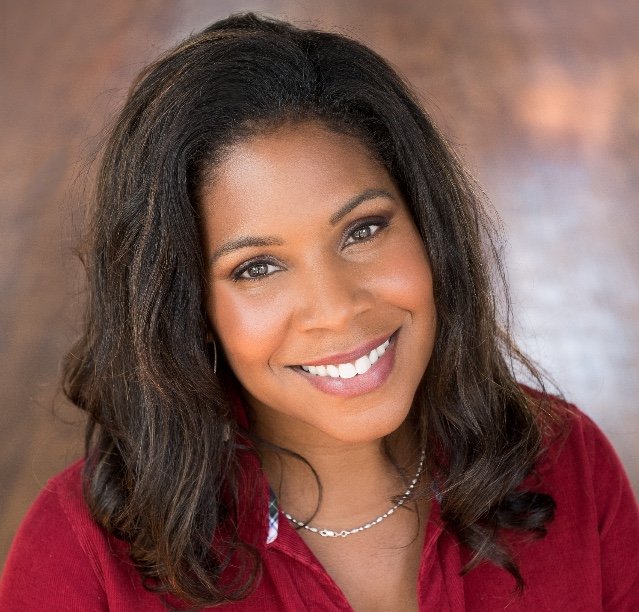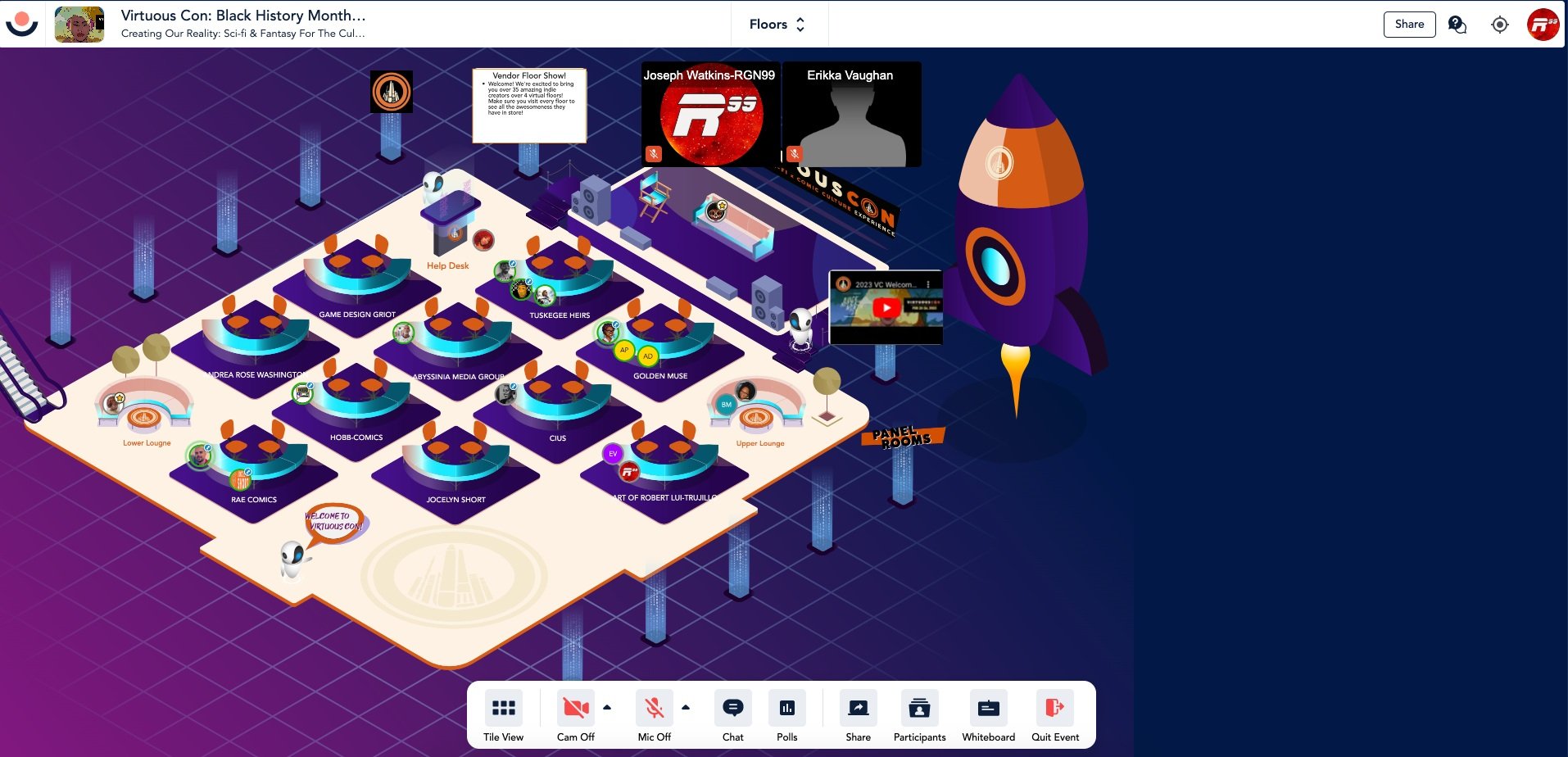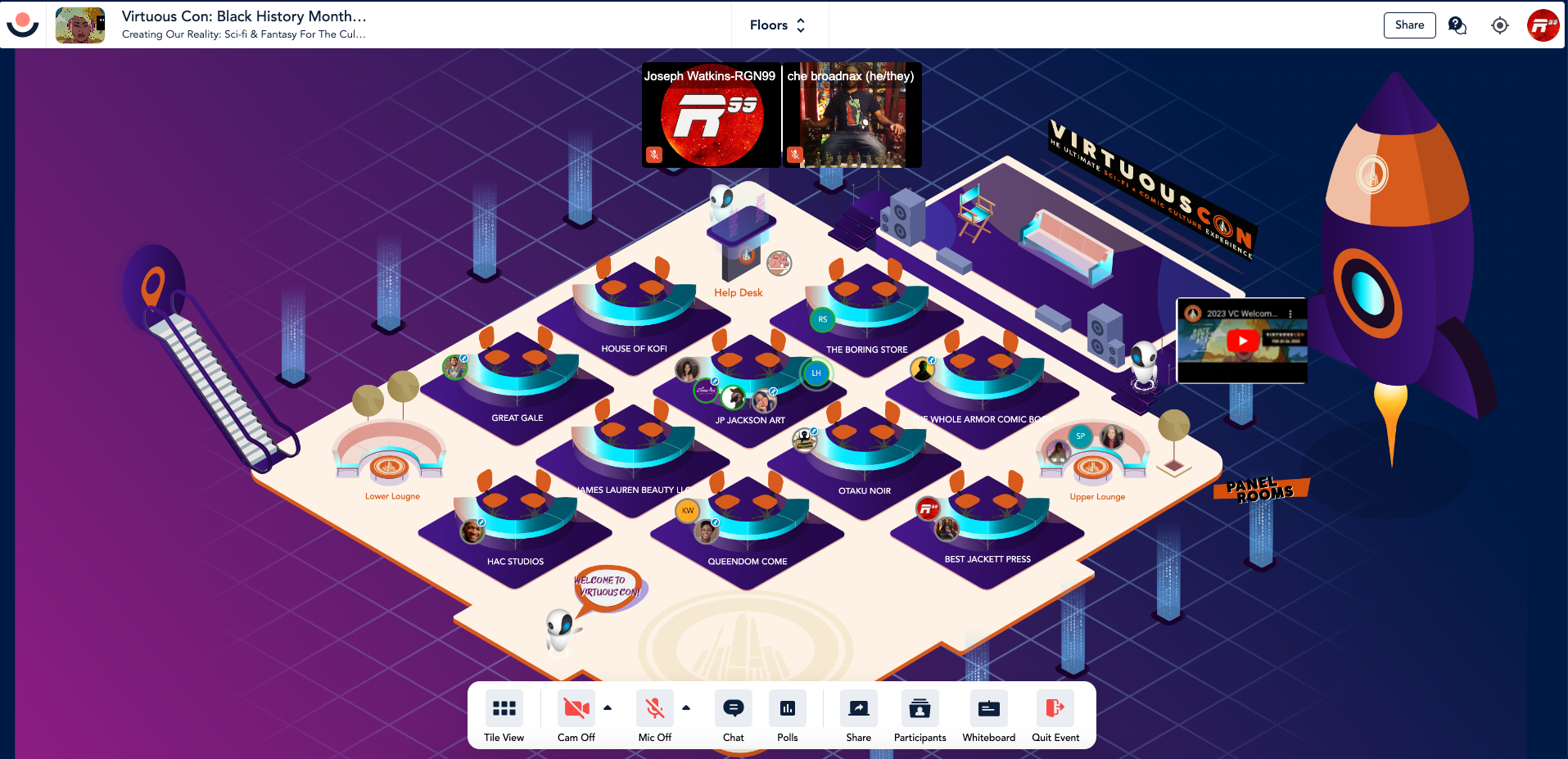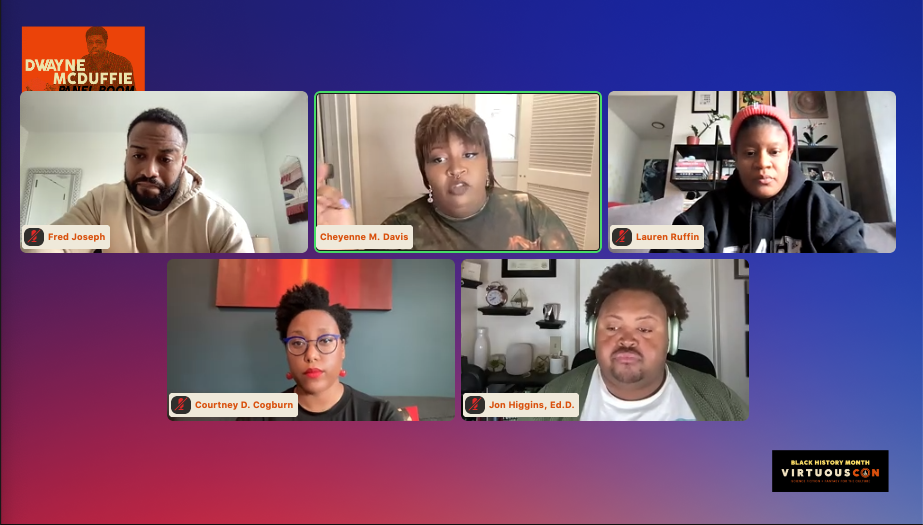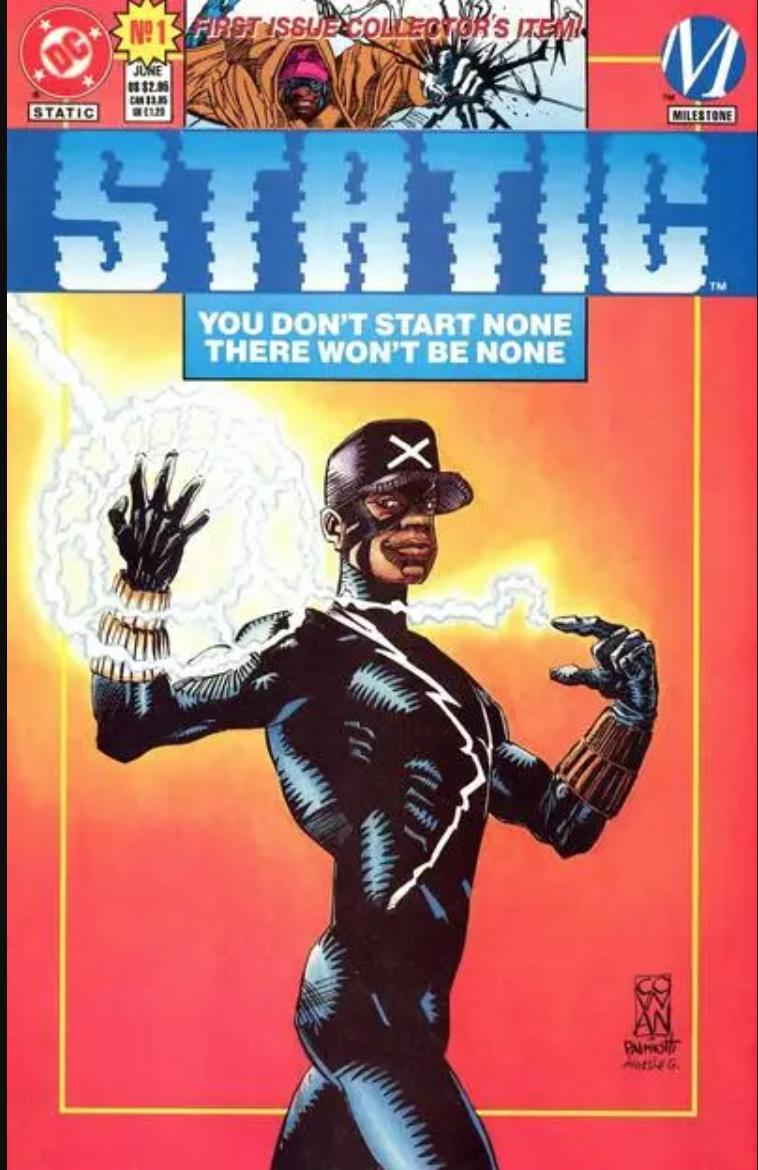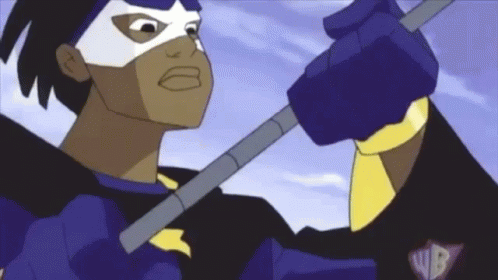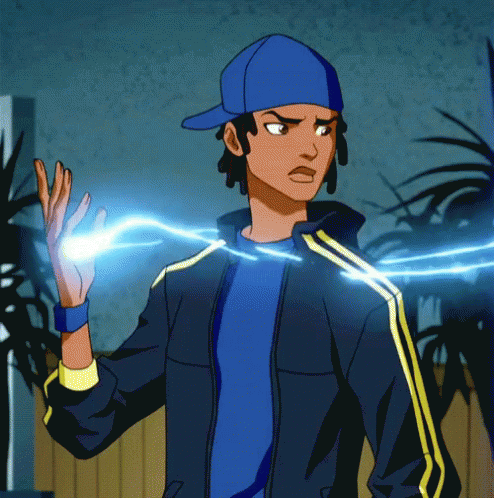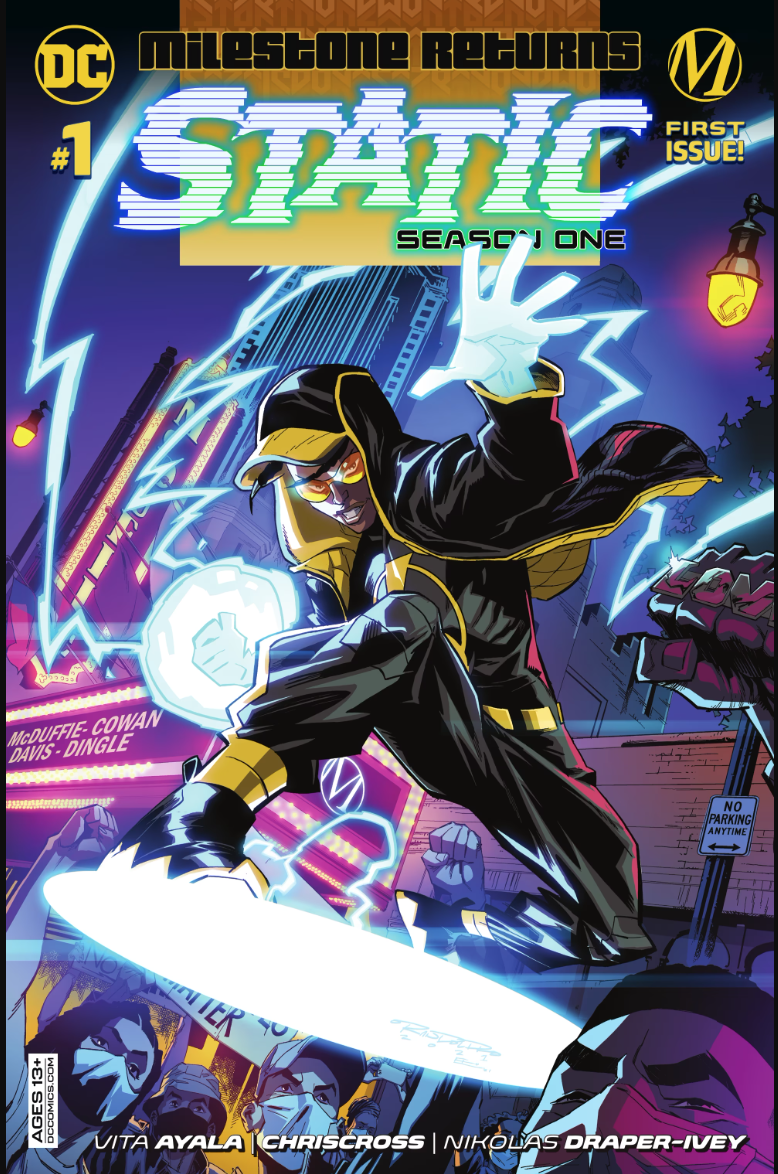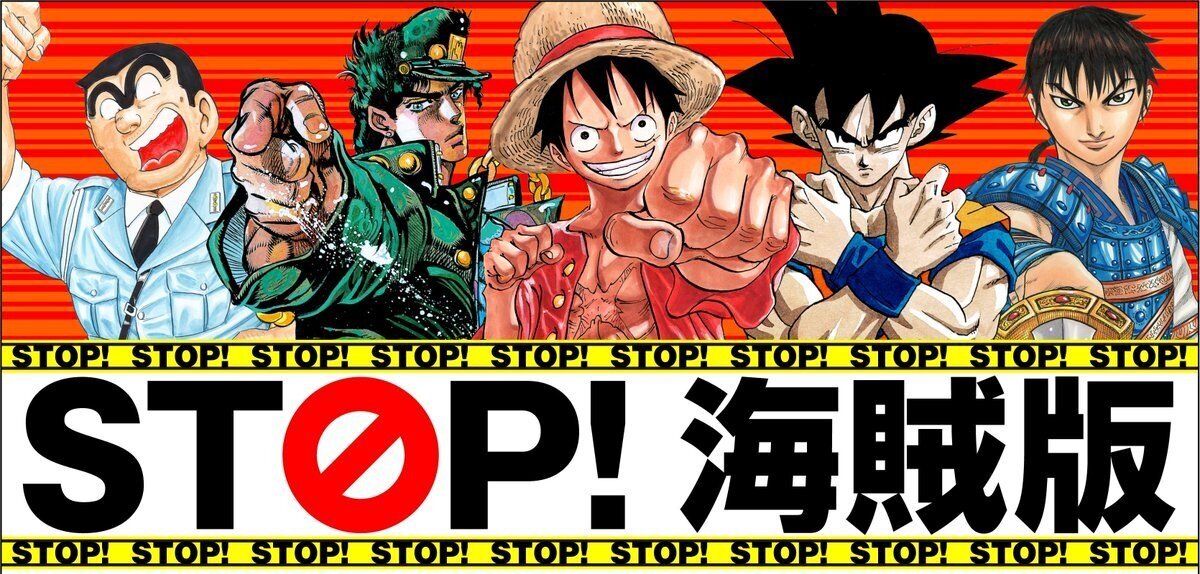VirtuousCon 23' - Welcome to the Blerd Metaverse.
Joseph W. Da Watcha
VirtuousCon 23’ (VC23) consists of a plethora of young, gifted and talented, Black creatives who are at the forefront of pop culture, Afrofuturism, and creativity. By navigating the matrix, Cerece Rennie Murphy has once again created an incredible two-day expedition into literature, comics, movies, art, and gaming within the digital multiverse. But VC23 is more than just a gathering of like minded individuals, it encompasses a massive 5-floor lounge for engagement and entertainment, and a remarkable digital shopping center. In this multiverse, patrons gather to share advice, show support for one another, and ask questions that relate to the future of the creative industry within a digital landscape. This year, she also opened the discussion about the future of art and the dreaded disruptor, Artificial Intelligence. Welcome to the Blerd Metaverse.
I would like to comment on my experience accessing Virtuous Con's network before diving into the panels. I found the entry process to be relatively easy, and as soon as I logged in, I was transported to a tech paradise where I had the opportunity to hear from some of the biggest names in the pop culture industry. I did have one issue - there was an overwhelming amount of content available. Each panel was like the glass jumping competition in Squid Games, with the exception that any panel choice was a good one and not a death sentence. The knowledge being shared was just as valuable as the information in the networking rooms and I now understand why Virtuouscon was dedicated to Octavia Butler and Dwayne McDuffie, two pioneering figures who fought for Black representation in media. Butler was the first science fiction writer to receive a MacArthur Fellowship, while McDuffie established a successful Black-owned and operated comic book company, MILESTONE COMICS!!!
Choosing which panel to attend could have made all the difference in your creative development, as authors, actors, and content creators dropped gems (wisdom) making the panels an amazing experience.
Black Identity x New Media
The internet is an ever-changing technological platform that is populated by numerous identities, diverse perspectives, and a multitude of cultures. Within this digital space, “culture takes on a distinct meaning where individuals can freely express themselves”, as noted by Fred Joseph, bestselling author of The Black Friend and Patriarchy Blues. For Black individuals navigating this online ecosystem, their cultural experiences differ from other racial groups, according to Lauren Ruffin, an associate professor at Arizona State University specializing in Worldbuilding and Futures. During a panel discussion on Black identity, Prof. John Higgins from the University of Redlands highlighted how social media has created safe spaces for people of color to speak their truth, while acknowledging the potential consequences of doing so. He noted that platforms like Tik-Tok, LinkedIn, and Twitter can act against users who speak out against systemic oppression, resulting in the erasure or blocking of their profiles:
“The ways that Tik-Tok, Linkedin and Twitter, will come after you for speaking truth to power. I know a number of friends who’ve had their platforms blocked or erased because they were naming the ways that systematic oppression was impacting them both, online and off”.
Social media has a skewed approach to handling people of color, as some platforms allow negative portrayals of the Black community to thrive, while others aim to uplift and positively impact the Black Diaspora. While Instagram, Twitter, and Facebook are primed for housing groups of color and canceling them, other applications such as, Quirkchat, FanBase, and GoodFeed, Black-owned and operated, welcome the Diaspora with open arms.
Data from the Pew Research Center indicate that social media is a necessary and personally important tool for Black Americans to get involved with issues they care about and to connect with like-minded individuals on specific topics. The Black community overall has created an organized nexus within the digital space with countless groups such as Blerd-Up, Blerdover, Blerdseyeview, the world-famous,Black Twitter, and a host of others. With many willing to praise and criticize their peers' in a comedic or serious way, social media, overall, has enabled many in the Blerd Diaspora to be unapologetically themselves and has provided strategies for creators to monetize their personality by becoming models, influencers, and creators, generating a new form of wealth for the culture, their families and communities.
Shonen vs. Everyone
In the panel, Shonen vs. Everyone: How Anime has Shaped the Culture, the cultural ethos is further expanded as host Jason L. Richardson, the CEO of the pop culture production company/news site J1 Studios, speaks with guests Patricia Mitchell and Bri Alphonso of the Black Ramen Podcast, Malcom Crawford of the Storm Podcast and CEO of Weird Enough Productions and manga creator, Tony Weaver Jr. Here, they discussed how the Blerd’s cultural identity has made anime grow into a billion-dollar industry with Battle Shonen leading the charge with anime hits such as Dragonball Z, Naruto and many others anime projects. Attack on Titan anyone?
Moving beyond the famed genre, panelists stressed that looking at other forms of manga and anime is acceptable, with Patricia Mitchell saying it best when she said, “Anime is now mainstreamed or pop culture because of us, Black people, we’re trendsetters. Anime Poppin.... it’s a fact.... there’s so much more to the story outside of battle shonen...try to look at other genres.”
According to Jason L. Richardson, the founder of J-1Con, the Blerd Diaspora is driven to the shonen market because the hero resonates with Black Nerds who also feel like outcasts among their own people:
“ The thing that drives us [Blerd Diaspora] and I’m generalizing now, to the shonen market, as Black folk, is that most of the time the hero is an outcast, that has to fight and struggle. All of us, being Black Nerds, fit into that category, because amongst our own people, like Naruto. We weren’t accepted because we were Black, but we weren’t Black enough, because we were into comic books, video games, anime and all this other stuff and now that we’ve become the various influencers...we’ve gone through our seasons, going to our different levels of super sayian...”
Goku - Super Sayian Blue Transformation
For the unfamiliar, reaching Super Sayian in the Dragonball-Z universe signifies reaching a new level in one's personal development. For the Blerd community, however, this concept holds a deeper meaning. As Jason L. Richardson explained, Blerds are drawn to the anime/manga of Dragonball-Z, because it portrays struggles with slavery and racism that people of color could possibly relate to. Blerds internalize these struggles and connect with them on a deeper level, making them a truth that resonates with their personal experiences.
With Shonen manga aimed at the male teenage audience, there are other types of manga for other audiences as well:
Shojo: manga aimed at the female teenage audience, featuring romance, drama, and relationships.
Seinen: manga aimed at adult men, often featuring mature themes, action, and adventure.
Josei: manga aimed at adult women, often featuring romance, relationships, and slice-of-life themes.
Kodomomuke: manga aimed at children, featuring themes and storylines appropriate for a young audience.
Yaoi: manga featuring romantic and/or sexual relationships between male characters, often created by female authors.
Yuri: manga featuring romantic and/or sexual relationships between female characters, often created by male authors.
Hentai: manga featuring explicit sexual content.
Gekiga: manga with a more serious and mature tone, often dealing with social issues, realism, social engagement, maturity, and masculinity.
Historical: manga set in a historical period, often featuring real-life events and figures.
Mecha: manga featuring giant robots or mechs as a central theme.
Sports: manga featuring various sports, often with a focus on a specific sport or team.
Horror: manga featuring horror and supernatural themes, often with elements of gore and violence.
Slice of life: manga depicting everyday life, often focusing on relationships and personal experiences.
Comedy: manga featuring humorous and comedic storylines and characters.
Tony Weaver Jr., a champion for diversity, equity, and inclusion in the media industry, has shed light on the business aspect of publication genres, highlighting how Black creators and contributors in the anime and manga community could profit from their work:
Tony Weaver Jr.
“Genres work from a business perspective. They let publishers know where they need to pay to put their marketing, they let the bookstores know where they need to put the book if they want to sell it.....
As a manga creator, something that I struggle with and that I talk to a lot of creators about is, like, ‘Bro, you don’t live in Japan, it’s cool, I don’t think you need to live in Japan to make a manga. If you don’t live in Japan, why are you hyper-fixated on the way that you pitch your work to a market that you don’t sell to? ‘ For the most part, if you’re a manga creator and you hit it big, you’re going to be working with an American publisher, and they’re going to put you in the graphic novel section with everybody else. You’re over here talking about shonen, shonen, SHONEN, you going to miss out on a check....focus on where your work fits in the marketplace and do more research in the market that you’re selling in.”
Shonen vs Everybody covered a range of topics such as portraying Black characters in a more relatable manner, promoting and nurturing the Black creative community, exploring the changing trends in cosplaying, and even delving into the realm of Artificial Intelligence (Ai). One of the panelists, Bri Alphonso, raised a question (from a viewer) regarding this subject:
“What are your views with Ai and Art especially in comic creation and manga generation? I want to add on to that, if these Ai’s start drawing Black characters, is that necessarily better?”
During the discussion, the panelists expressed their preference for human artists, and this perspective stood out as the majority of the panelists shared the same viewpoint about Ai:
Bri Alphonso: “.... I hate having a lot of these Ai’s making comics and art, because I feel like, people should be making art, and it kind of takes out from the meaning...
Tony Weaver Jr.: “.....It’s not a magic bullet... Ai as technology is drawing from a base of art that it is getting from other places. And many times the art that its getting from other places doesn’t have consent to be pulling from....
Jason L. Richardson: “...A lot of people are trying to sue over that [Ai art without consent] and “I look at Ai art as a glorified filter. “
Malcom Crawford: “.....it’s cool for a PFP, but a whole manga off of that [Ai] is kind of crazy...”
The panelists demonstrated their unanimous agreement with Bri's opinion that Ai art undermines both the artists and the art itself by collectively nodding in response to the following statement:
“You’re cheating artists and you’re cheating art out of people.”
Ai tools are now widely available, enabling individuals without access to conventional art supplies or an art background to create digital art. This provides opportunities for a more diverse range of creators to participate in the art world, including those who previously may not have had the chance to pursue their artistic dreams in the past. While the evolution of Ai is fascinating, it also raises concerns among artists about their abilities and job security. As the art world evolves alongside technological advancements, it remains to be seen how the relationship between Ai and artists will evolve, but one thing is clear, Ai is changing the landscape of the art industry, and artists might have to adapt to these changes as soon as possible or perish in the transition.
Indie Vs. Big 2
In the same spirit as the Shonen vs. Everybody panel, the next event focused on the world of comic books. The atmosphere was similarly energetic, as panelists delved into discussions about expanding the legacy of comic book characters beyond their original creators.
Aaron Perine, the host of the Marvel podcast Phase-Zero-MCU on Comicbook.com, led the panel discussion which covered several topics including legacy building for Black characters, DC Comics' expanding goals, and the difference between writing for voice and writing for work. The panelists included Eisner Award winning artist Alitha Martinez; Brandon Thomas, renowned writer and co-creator of the highly acclaimed series EXCELLENCE by Skybound/Image; Mellow Brown, screenwriter for the Writers Guild of America West; Vita Ayala, writer for DC, Marvel, Image, and other leading publishers, and Nikolas Draper-Ivey (NDI), the celebrated artist behind the artwork of the acclaimed Milestone/DC series, Static.
Developing a legacy character through writing and art is a significant responsibility, as it requires maintaining the established values and characteristics of the original character while also adding your personal perspectives and creativity to the character's growth. In my opinion, this reflects, what I would like to call, the “All-Might Enigma”. As Deku obtained his powers from his predecessor All-Might, over time, he discovered that he had additional powers from former All-Might holders which assisted him into becoming a more evolved and powerful superhero while incorporating the beliefs of the original bearers of the All-Might superpower. With Milestone’s/DC Comic’s Static, the past and present collide as the character evolves and faces new challenges while staying true to the original values that made him a hit with fans. With Vita Ayala and Nikolas Draper-Ivy providing an authentic, modernized approach to this phenomenal character. It feels great to know that DC has the right people at the helm guiding his growth and development.
NDI also provided a great interpretation for Static’s evolution:
Nikolas Draper Ivory
“It’s tricky, with so many things that have come out since the original Static aired. It’s rough because so many things have come out, and it’s cool, and, you have to play catch up with the character and put him in the same kind of flashiness, if you will, that these other characters have...you have to take someone and kind of upgrade him...ALOT, just so he can have a fighting chance to be seen. Some people don’t even know who Static is, and the people who do know who Static is, know Static Shock, the cartoon...What I will say is ‘the people that grew up with it [Static] and want to see it again, want to see it done right’…You have to remember that the audience has grown up and the people that read the older Milestone stuff are much older. You have to make sure that they are also included and seen also.”
Heavy is the crown as NDI and Vita Ayala have skillfully integrated both past and present elements in their depiction of Static as a hero for the next generation. The task of representing a character who has been a beloved figure for decades, while also infusing new energy into the character to appeal to a modern audience, can be a daunting challenge. NDI and Vita Ayala have successfully accomplished this feat by striking a balance between honoring the character's rich history and introducing fresh perspectives that speak to the current generation.
Artificial Intelligence X Law
The final panel of the event focused on the elephant in the room, Artificial Intelligence (Ai). Ai has increasingly dominated the creative field with the rise of machine learning and their powered tools have transformed the creative arts industry, up to, and including the music, literature, and film industry.
Entertainment Lawyer of Yates and Speroni Law Group, LLC, Wynton Yates describes Ai perfectly,
“...these Ai platforms across the board, whether you’re talking about Midjourney, stability.Ai..., any of them, the programmers and developers that are creating these Ai platforms “train them” by scraping the internet. You’re going to hear a lot of them refer to the term as “scraping”. To me, as an attorney, this is just a very “spicy way” of saying, ‘they’re going out, they’re looking at existing art, creative works that exist out on the internet, then it can go out, learn from, and pull into its systems. Once an Ai platform is trained, users can then go into that platform, key in certain prompts telling it what they want to generate.”
Yates' observation that Ai's artworks are "generated" rather than "created" highlight a critical issue regarding the ownership rights of Ai-generated works. With traditional creators now competing against Ai-generated content, obtaining intellectual property rights has become a major challenge for those favoring Ai. As of this writing, Midjourney, an Ai image generator, is in a lawsuit regarding IP rights for works of art found on the internet. This is particularly significant since there is, as Yates discussed, “a lack of established litigation and legislation to govern Ai’s - generated content ownership”.
As a result, intellectual property ownership has become more crucial than ever, given Ai's growing ability to produce creative works in the guise of voice, artwork, scripts, and written work. For example, Apple is experimenting with its language generating Ai to launch Ai-powered audio narration for their audio books. While this is a noble endeavor, the use of Ai-generated audio narration could potentially enhance the overall audiobook experience for consumers while also providing more efficiency for publishers. This disruption may also raise concerns for renowned actors, actresses, and professional voice actors working in the media industry. Could they be out of a job? Could Christopher Sabat, the voice of Vegeta, All Might and other iconic anime characters, be tossed to the wayside as Ai takes over his role?
A very serious concern indeed.
Final Thoughts
The media holds immense power in shaping our perceptions of the world and its inhabitants. When Black identity is authentically and positively portrayed in various forms of media such as comics, anime, manga, video games, etc, it not only reduces harmful stereotypes but also increases awareness and understanding of the Black, diaspora among viewers.
Virtuouscon 23' is one of those communities that provide for Blerds, Black creatives, and many more, the opportunity to share their interests and express their cultural identity in a positive space, while exploring new ideas and opinions about the media.
In 2022, Jason M. Allen emerged as the winner of the annual Colorado State Fair art competition, using an app called Midjourney to create an ultra-futuristic "D'Opera" that could be likened to a scene from the sci-fi classic The Fifth Element. While this may seem like an awesome success story, it highlights the growing use of Ai in art generation, which has received mixed reviews from both artists and critics. For many artists, the years of training and hard work required to master their craft are now being replaced by lines of computer code that do the painting and drawing, with growing concerns about whether Ai could ultimately eliminate the need for traditional artists, commission-based artists, even art teachers. The rise of Ai is a topic that warrants attention and was addressed by several panelists at Virtuous Con, as they prepared us for the next art revolution.
VirtuousCon 23 was more than just a platform for showcasing pop culture, it was a trip into the Blerd metaverse and I can’t wait till next year to experience it again.
P.S. - I also need to give a shoutout to the other panelists who provide their love and energy to this phenomenal event. They were amazing as well.



